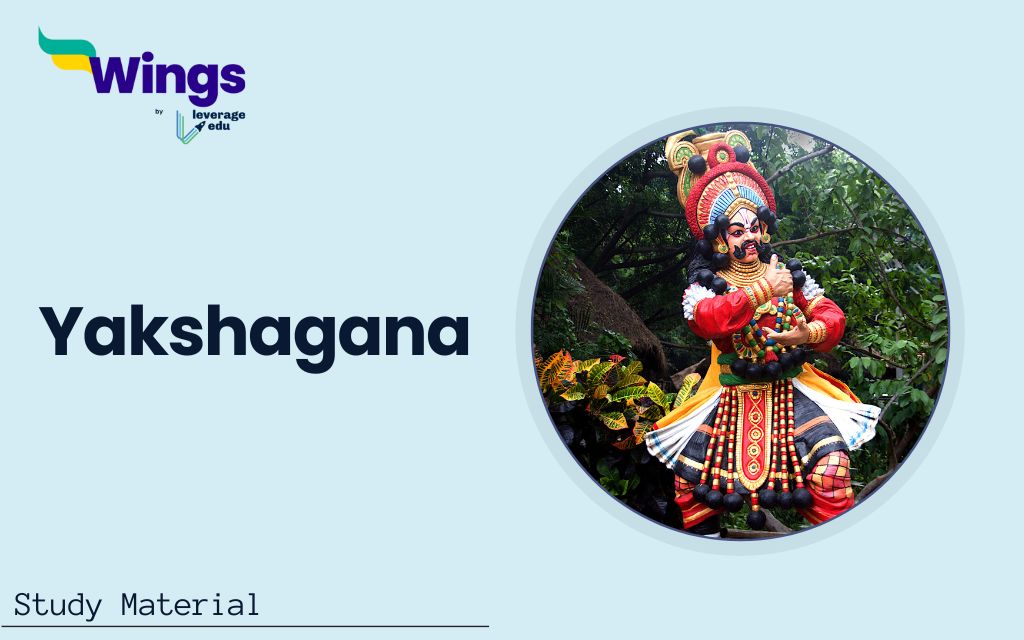One type of traditional folk dance is called Yakshagana. It is well-liked in some areas of Kerala and the coastal districts of Karnataka. The Vaishnavite bhakti movement is where the Yakshagana dance developed. It is an amazing fusion of song, dancing, music, intellectual discussions, and colorful costumes.
India exhibits a diverse and expansive art and culture. For the UPSC Civil Services test, knowledge of traditional dance forms, festivals, etc., is essential. According to the General Studies (GS-1) paper syllabus and the Art and Culture Prelims exam syllabus, it is pertinent. Direct, factual, and analytical inquiries have been posed regarding these subjects time and time again. The essential elements of Yakshagana will be covered in this article.
Contents
What is Yakshagana?
A type of traditional folk dance known as yakshagana is prominent in Kerala’s Kasargod region and Karnataka’s coastal areas. The term “Yakshagana” refers to the song (gana) of the spirits or demi-gods (Yaksha).
- It is typically presented in outdoor theatres at night.
- Yakshagana Karnataka is performed on the villagers’ paddy fields following the winter crop harvest.
- It was previously exclusively done by guys. but now, both, men and women take part in the Yakshagana.
Also Read: Temple Architecture and Different Styles
History of Yakshagana
- The South Indian states of Karnataka and Kerala are the birthplaces of the age-old theatre form known as yakshagana. Its origins dates from the 11 to the sixteenth centuries CE. It is thought to have developed from more traditional performance art and narrative genres.
- “Yakshagana” originates from the Sanskrit terms “yaksha” and “gana.” Translated, they mean “song” and “celestial being” respectively. This implies that Yakshagana was initially connected to performances thought to have been divinely inspired.
- Yakshagana was initially practiced in outdoor areas and courtyards of temples. Many times, shows went on for several nights. Usually, they were inspired by tales from Hindu mythology, especially the epics of Ramayana and Mahabharata.
- Yakshagana evolved its own distinct performance style over time. Additionally, as the performances developed, dance, mime, and improvisational components were included.
- Yakshagana was important to South India’s religious and cultural life. It functioned as a means for spreading morals and religious ideas.
- Around the middle of the 20th century, Yakshagana started to shift. Indoor stages were becoming more and more common for performances. Women started taking part in the artistic medium. With these modifications, Yakshagana was given new life and made accessible to a larger audience.
Different Yakshagana Variants
There are two different styles of Yakshagana: Tenkutittu and Badagutittu. The instruments used, the outfits donned, and the general aesthetic set these genres apart.
Badagutittu Style
The north of South Canara is home to many Badagutittu artists. The usage of a traditional Karnataka chande drum is what distinguishes it. Yakshagana Mandira by Shivram Karanth is credited with popularising this style. It offered Yakshagana in a condensed, contemporary version.
Tenkutittu Style
In the southern regions of South Canara, the Tenkutittu style is predominant. The Kerala maddalam, a double-sided, leather-headed drum crafted from jackfruit tree wood, is what sets it apart. The Tenkutittu type costumes are less flamboyant, especially those of demons. This makes it more like Kathakali than Badagutittu. Renowned Yakshagana practitioner in the Tenkutittu style were Sheni Gopalakrishna Bhat.
Also Read: Hindustani And Carnatic Music
Salient Features of Yakshagana
Key elements of Yakshagana that are crucial for the UPSC IAS exam are:
- It is among the oldest forms of theatre in Karnataka.
- The Jakkula Varu people performed it in the Vijayanagara dynasty’s court.
- The Ghandharva grama musical system serves as the foundation for the Yakshagana performance.
- The Vaishnava Bhakti movements had an influence on Yakshagana in its current form.
- It is similar to Theyyam and Bhoota-kola.
- Some Karnataka communities used to refer to it as “Bayatala.”
- There are fifteen to twenty actors in the Yakshagana performance group.
- The exquisite speech, dancing steps, and facial emotions are what make the Yakshagana so unique.
- Usually, the dialogues are spoken in Sanskrit, Tulu, or Kannada.
- There are two Yakshagana subgroups:
- Moodalopaya: This is the earliest version and is very popular in East Karnataka.
- Paduvlopaya: In West Karnataka, it is well-liked.
- Three sub-groups comprise the Paduvlopaya form:
- Badagutittu
- Badabadagutittu
- Tenkutittu
Famous Yakshagana Artists
Some of the most famous Yakshagana artists are:
- Keremane Shivarama Heggade
- Sheni Gopalakrishna Bhat
- B. N. Nanjunda Rao
- N. L. Narasimhachar
- T. K. Lakshminarayana
FAQs
The Yakshagana is credited to its inventor, Keremane Shivarama Hegde. The first known written record of Yakshagana can be discovered on an inscription from 1556 CE at the Lakshminarayana Temple in Bellary District.
Yakshagana is a type of stage dance, while Gombeyatta is a puppet art form.
The chenda, maddalam, jagatta or chengila (cymbals), and chakratala or elathalam (little cymbals) are the musical instruments utilised in the Yakshagana.
RELATED BLOGS
This was all about the “Yakshagana”. For more such informative blogs, check out our Study Material Section, or you can learn more about us by visiting our Indian exams page.
 One app for all your study abroad needs
One app for all your study abroad needs














